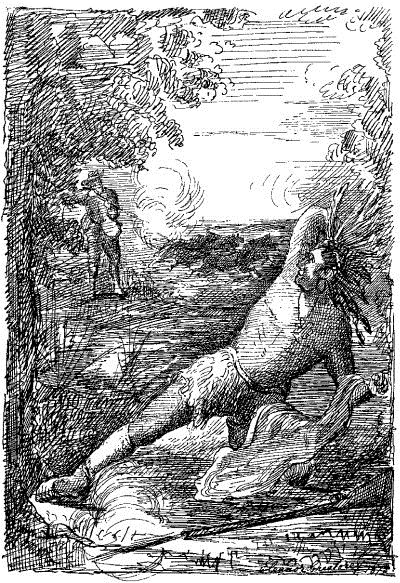 полная версия
полная версияChristopher Carson, Familiarly Known as Kit Carson
"A hunter's camp in the Rocky mountains is quite a picture. It is invariably made in a picturesque locality. Nothing can be more social and cheering than the welcome blaze of the camp fire on a cold winter's night."
Young Carson, alone with his horse and mule, would journey from fifty to a hundred miles, examining every creek and stream, keeping a sharp lookout for signs of beaver. Having selected his location, generally in some valley eight or ten miles in extent, with a winding stream circling through the centre, which he had reason to believe was well stocked with beaver, he would choose a position for his camp. This would be more or less elaborate in its construction, according to the time he intended to spend there. But he would always find some sunny nook, with a southern exposure and a pleasing prospect, near the brook or some spring of sweet water, and, if possible, with forest or rock sheltering from the north winds.
In a few hours young Carson would construct his half-faced cabin, as the hunting-camp was called. A large log generally furnished the foundation of the back part of the hut. Four stout stakes were then planted in the ground so as to inclose a space about eight feet square. These stakes were crotched at the ends, so as to support others for the roof. The front was about five feet high, the back not more than four. The whole slope of the roof was from the front to the back. The covering was made of bark or slabs and sometimes of skins. The sides were covered in a similar way. The whole of the front was open. The smooth ground floor was strewed with fragrant hemlock branches, over which were spread blankets or buffalo robes. In front of the opening the camp fire could be built, or on the one side or the other, in accordance with the wind.
Thus in a few hours young Carson would erect him a home, so cosey and cheerful in its aspect as to be attractive to every eye. Reclining upon mattresses really luxurious in their softness, he could bask in the beams of the sun, circling low in its winter revolutions, or gaze at night upon the brilliant stars, and not unfrequently have spread out before him an extended prospect of as rich natural scenery as ever cheered the eye. He had no anxiety about food. His hook or his rifle supplied him abundantly with what he deemed the richest viands. He knew where were the tender cuts. He knew how to cook them deliciously. And he had an appetite to relish them.
Having thus provided himself with a habitation, he took his traps and, either on foot or on horseback, as the character of the region or the distance to be traversed might render best, followed along the windings of the stream till he came to a beaver dam. He would examine the water carefully to find some shallow which the beavers must pass in crossing from shoal to deep water. Here he would plant his trap, always under water, and carefully adjust the bait. He would then follow on to another dam, and thus proceed till six traps were set, which was the usual number taken on such an expedition.
Early every morning he would mount his horse or mule and take the round of his traps, which generally required a journey of several miles. The captured animals were skinned on the spot, and the skins only, with the tails which the hunters deemed a great luxury as an article of food, were taken to the camp. Then the skin was stretched over a framework to dry. When dry it was folded into a square sheet, the fur turned inward and a bundle made containing from ten to twenty skins tightly pressed and corded, which was ready for transportation. These skins were then worth about eight dollars per pound.
After an absence of three or four weeks, young Carson would return with his treasures, often several hundred dollars in value, to the rendezvous of Mr. Ewing Young at Taos. Soon again he would set out on another similar expedition. Thus Carson passed the winter of 1827.
CHAPTER III.
Among the Trappers
The Discomfited Trappers.—The New Party Organized.—A Battle with the Indians.—Trapping on the Colorado.—March to the Sacramento.—The Friendly Indians.—Crossing the Desert.—Instinct of the Mule.—The Enchanting Valley of the Colorado.—The Mission of San Gabriel.—Vast Herds of Cattle.—The Mission of San Fernando.—Adventures in the Valley of San Joaquin.—The Meeting of two Trapping Bands.—Reasons for Kit Carson's Celebrity.—A Military Expedition.—The Indian Horse Thieves.—The Pursuit and Capture.
Soon after Carson returned to the cabin of Mr. Young from one of his trapping expeditions, a party of trappers came back who had set out to explore the valley of the Colorado, in pursuit of furs. At Taos they were west of the Rocky mountains, and the route which they were to take led them still farther in a northwest direction, a distance of three or four hundred miles. It was known that the region was full of roving Indians, and it was not doubted that the savages, if they saw any chance of overpowering the trappers, would do so, and seize their effects, which to the Indians would prove booty of almost inconceivable value. The rifle gave the trappers such an advantage over the Indian, with his bow and arrows, that they never hesitated, when upon the open plain in encountering almost any superiority of numbers.
This party of eighteen trappers, with their horses and heavily laden mules, had advanced but a few days' journey, over an almost unexplored region, when they fell in with a powerful tribe of Indians, who, after a little palaver, seeing their weakness in numbers and the richness of their treasure, attacked them with great fury. The Indians had adroitly selected a spot where they could fight Indian fashion, from behind trees and logs. The battle lasted a whole day. We are not informed how many of either party fell in the fray. But the Indians seemed to swarm around the trappers in countless numbers, and the white men were, greatly to their chagrin, driven back with the loss of several mules.
As the discomfited party returned with their tale of disaster, the ire of Mr. Young was raised. It is a comment upon the number of men then roving the wilderness, that Mr. Young was in a short time enabled to organize another party of forty men, to resume the enterprise. It was a motley collection of Spaniards, Americans, Mexicans and half-breeds. Proudly this powerful band, well armed, well mounted and with heavily laden pack mules, commenced its adventurous march, burning with the desire to avenge the insult which the previous expedition had encountered.
Mr. Young had learned highly to prize the capabilities of young Carson, and engaged him to take a prominent position in this company on its hazardous tour. After a march of about a hundred miles, they reached the region occupied by the Indians who had attacked and defeated the former band. The savages, flushed by success, were all ready to renew the conflict. Mr. Young himself was the leader of the party. The Indians, by their gestures and shouts of defiance, gave unmistakable evidence of their eagerness for the fight.
There was some little delay as both parties prepared for the deadly strife. Mr. Young, a veteran in the tactics of the forest, posted his men with great sagacity. He had forty, as we have mentioned, in all. Twenty-five of them he hid in ambush. With the other fifteen he cautiously advanced, and at length, as if alarmed, halted. The eminences all in front of them, seemed filled with the plumed warriors. The previous conflict had taught them the powers of the deadly rifle bullet. They kept at a respectful distance, never advancing unless protected by some tree or rock.
But there were hundreds of savages almost surrounding the little band, and making the hills and plains resound with the hideous war-whoop. When the trappers halted and began slowly to draw back, a deafening shout arose from the triumphant foe, and in a simultaneous charge they advanced, but still cautiously, not venturing near enough to discharge their arrows. They were thus drawn along into the trap. When fairly within rifle range, twenty-five unerring marksmen from their concealment, almost at the same instant, opened a death-dealing volley upon the surprised and bewildered warriors. The slaughter was terrible beyond anything they had ever, in their native battles, witnessed before. Twenty-five of their bravest warriors, for the bravest were in the advance, fell dead or severely wounded. The Indians were thrown into an utter panic.
The thunder, the lightning, and the death-bolts had come from they knew not where. With almost the rapidity of thought the rifles were again loaded and the whole united band rushed forward upon the Indians who were now flying wildly in all directions. Instinct taught them to perform all sorts of gyrations to avoid the bullets which pursued them. They made no attempt to rally, though many of their proud warriors were left behind lifeless, or struggling in the convulsions of death.
The power of the rifle was such that, in those days, forty or fifty men never hesitated to engage whole tribe, though it might number one or two thousand warriors. A man will fight with terrible persistence when he knows that defeat is inevitable death by torture. It is a thousandfold better to fall beneath the arrow, the tomahawk or the war-club, than to be consumed alive amid the jeers and tortures of yelling Indians inspired with demoniac instincts. Thus with the trapper it was always either victory or death.
These hostile warriors were punished with a severity never to be forgotten. The fugitives carried far and wide to other roving tribes the tidings of their disaster. The bold trappers proceeded on their way, encountering no more serious molestation. Smoke upon the distant hills indicated that their march was watched. If a trap was set at any distance from the night's encampment, it was pretty surely stolen. Or if a weary mule was left to recruit, a little behind, intending to bring him up in the morning, before the dawn he disappeared.
The whole party followed slowly down a tributary of the Colorado river, very successfully trapping upon the main stream and its branches, until they reached the head waters of the San Francisco river. They then divided, and Mr. Young with Carson and seventeen others proceeded several hundred miles farther west, to the valley of the Sacramento. Before setting out for this long journey, as it was uncertain what game they might find by the way, two or three days were devoted to hunting. The skins of three deer were converted into water tanks, which were without difficulty carried by the mules. They were induced to this caution because some friendly Indians had assured them that there was a great destitution of water by the way.
On their march they encountered a tribe of Indians in all their native wildness. They were very friendly though they had apparently never seen a white man before. Perhaps their friendliness was because they had never yet met any of the pale faces, from whom they subsequently suffered such great wrongs. These Indians presented remarkably fine specimens of the physical man. They were tall, erect and admirably proportioned. Their features were European, their eyes very full and expressive, and the dress of men and women simple in the extreme. They were all splendid horsemen, and often as they entered the camp at full speed on their spirited chargers, it seemed as though the steed and its rider, like the fabled centaur, were but one animal. Their bodies were painted and oiled so as to resemble highly polished mahogany.
The travellers found the information communicated to them by the friendly Indians to be true. For four days they travelled over a dreary, sandy waste, where there were neither streams nor springs. At the camping place each night there was given from the tanks, a small amount of water to each animal and man, but only enough to sustain life. A guard was set over the rest, for should any accident befall it the destruction of the whole party would be the probable consequence.
As they were toiling along the fifth day, painfully through the sand, the mules began to manifest a strange excitement. They pricked up their ears, snuffed the air, then began to rush forward with all the speed their exhausted strength would allow. The sagacious animals had scented water at the distance of nearly a mile. It was a clear running stream, fringed with grass and shrubs. When the first mule reached the water, the remainder were scattered for a great distance along the trail. Here the party encamped and remained for two days to recruit.
The bags of deerskin were again filled with water and the journey was resumed. The route still led over a similar barren region, where both man and beast suffered great privations from the want of water. On the fourth day they came in sight of the splendid valley of the great Colorado. It was with a thrill of delight that they gazed upon its verdure and its luxuriance, which were an hundredfold enhanced from the contrast with the dreary region which they had just traversed.
In their march of eight days through this barren and gameless region, their provisions had become quite exhausted. They chanced to come across some Indians from whom they purchased an old mare. The animal was promptly cut up, cooked and eaten with great gusto. They also obtained, from the same Indians, a small quantity of corn and beans. In the rich meadows of the Colorado our adventurers again found abundance. They spent a few delightful days here, feasting, trapping and hunting. The animals found, for them, a paradise in the luxuriant pastures of wild oats.
Again the journey to the west was resumed. The account we have of their movements is so meagre that it is impossible to follow with accuracy the route they traversed. They followed for some leagues a river, when suddenly its waters disappeared. They apparently sank beneath the surface of the quicksands. Still there were indications which enabled them to follow the course of the river, until finally it rose again above the surface, and in the open air flowed on to the ocean.
At length they reached the celebrated Catholic Mission of San Gabriel, near the Pacific coast. The Mission was then in a flourishing condition. The statistics, published in 1829, indicate a degree of prosperity which seems almost incredible. More than a thousand Indians were attached to the Mission, and were laboring in its widely-extended fields, tending its herds and cultivating the soil. The poor Indians, who were often half starved upon the plains, found here light employment, shelter and abundant food. The statistics to which we refer, state that the Mission had seventy thousand head of cattle, four thousand two hundred horses, four hundred mules, and two hundred and fifty sheep.
These Missions, several of which were established in a line, within about fifty miles of the Pacific coast, belonged to the Spanish government, and were supported by the revenues of the crown. Animals multiplied with great rapidity upon those luxuriant and almost boundless prairies. They ranged sometimes, it was said, spreading out over a hundred thousand acres of wonderfully fertile pastures. There must of course, have been much guess-work in estimating the numbers of these vast herds, generally wandering unattended at their pleasure. But with such supplies of animal and vegetable food there was no fear of want. The indolent Indians consequently gathered around the Missions in great numbers. They were all fond of show, and not unwillingly became such Christians as consists in attending the ceremonies of the church.
The Mission, with its buildings, cultivated fields and vast herds, seemed like the garden of Eden to our weary travellers. They however, remained here but one day, as they were not on a tour of pleasure but in pursuit of furs. A day's travel brought them to another but much smaller Mission, called San Fernando. Without any delay they pushed on towards the west, their object being to enter the valley of the Sacramento river, where they had been told that beavers could be found in great abundance. They expected to reach the banks of this now renowned, but then scarcely known river, after a few days' journey in a northeast direction. They were now in a delightful region. The climate was charming. Brooks of crystal water, and well filled with fishes, often crossed their path. There was abundant forage for their cattle; and forest and prairie seemed alive with game.
They soon reached the banks of the San Joaquin, a lovely stream flowing northerly and emptying into the Sacramento near its mouth. There, finding a very eligible camping site, and many indications of beaver in the stream, Mr. Young halted his party, to rest for a few days, and in the meantime to set their traps. The general character of the scenery around them may be inferred from Mr. Bryant's description of a similar encampment in his overland journey to California.
"Finding here an abundance of grass, we remained the following day for the benefit of our animals. The valley was probably fifteen miles in length, with a variable width of two or three miles. It was a delightful spot. Wild plants grew in profusion, many-hued flowers studded its surface, and silvery streams, bordered by luxuriant verdure and shrubs, were winding through it. On both sides the mountains towered up by continuous elevations of several thousand feet, exhibiting a succession of rich vegetation, and then craggy and sterile cliffs, capped by virgin snow, the whole forming a landscape of rare combinations of the beautiful and sublime."
After a short rest the trappers continued their journey slowly, setting their traps on the San Joaquin and its tributaries. Pretty soon, much to their surprise, they saw indications that there was another band trapping on the same streams. In a short time they met, and it was found that the other party belonged to the Hudson Bay Company, and was commanded by Peter Ogden.
It is pleasant to record that the two parties, instead of fighting each other as rivals, cordially fraternized. For several weeks they trapped near together, often meeting and ever interchanging the courtesies of brotherly kindness. These men were from Canada. They were veterans in the profession of hunting and trapping, having long been in the employment of the Hudson Bay Company, and having served a regular apprenticeship to prepare them for their difficult and arduous employment. Here again the peculiarity of Kit Carson's character was developed. Instead of assuming that he knew all that was to be known about the wilderness, and the business in which he was engaged, he lost no opportunity of acquiring all the information he could from these strangers. He questioned them very carefully, and his experience was such as to enable him to ask just such questions as were most important.
There is scarcely a man in America who has not heard the name of Kit Carson. No man can make his name known among the forty millions of this continent, unless there be something extraordinary in his character and achievements. Kit Carson was an extraordinary character. His wide-spread fame was not the result of accident. His achievements were not merely impulsive movements. He was a man of pure mind, of high morality, and intensely devoted to the life-work which he had chosen. His studies during the winter in the cabin of Kin Cade, had made him a proficient in the colloquial Spanish language. This proved to him an invaluable acquisition. He had also gathered and stored away in his retentive memory all that this veteran ranger of the woods could communicate respecting the geography of the Far West, the difficulties to be encountered and the mode of surmounting them. And now he was learning everything that could be learned from these Canadian boatmen and rangers.
Already young Carson had attained eminence. It was often said, "No matter what happens, Kit Carson always knows at the moment exactly what is best to be done."
Both as a hunter and a trapper, though he had not yet attained the age of manhood, he was admitted to be the ablest man in the party. And his native dignity of person and sobriety of manners commanded universal respect. In this lovely valley both parties lived, as trappers, luxuriously. They were very successful with their traps. And deer, elk and antelope were roving about in such thousands, that any number could be easily taken. These were indeed the sunny, festival days of our adventurers.
The two united parties, trapping all the way, followed down the valley of San Joaquin to the Sacramento. Here they separated. The Hudson Bay Company set out for the Columbia river. Mr. Young and his party remained to trap in the valley of the Sacramento. At this time an event occurred which again illustrates the fearlessness, sagacity and energy of Kit Carson.
Not very far from their encampment there was the Catholic Mission of San Rafael. Some Indians belonging to that Mission, after committing sundry atrocities, fled, and took refuge in a distant Indian village. It was deemed important, in order that the Indians might be held under salutary restraint, that such a crime should not go unpunished. A force was sent to demand the surrender of the fugitives. But the Indians assumed a hostile attitude, refused to give up the criminals, and fiercely attacking the Mission party, drove them back with loss.
The Mission applied to the trappers for assistance. The request was promptly granted. Such a victory would puff up the Indians, render them insolent, and encourage them to make war upon other parties of the whites. Eleven volunteers were selected for the expedition, and the young and fragile Kit Carson was entrusted with the command. In manners he was gentle as a girl, with a voice as soft as that of a woman. He had no herculean powers of muscle, but he had mind, mental powers which had been developed in a hundred emergencies. And these stout, hardy veterans of the wilderness seem with one accord to have decided that he was the fitting one to lead them into battle, where they were to encounter perhaps hundreds of savage warriors.

Cautiously Kit Carson led his little band so as to approach the Indian village unperceived. At a given signal they raised the war-whoop and impetuously charged into the cluster of wigwams. As the terrified warriors rushed out of the huts, all unprepared for battle, these unerring marksmen laid them low. One-third of the warriors were slain. The rest fled in dismay. The village was captured with the women and the children. The victorious Carson then demanded the immediate surrender of the criminals. The next day they were brought in, strongly bound, and delivered to the Mission. With his heroic little band Kit Carson returned to the encampment, apparently unconscious that he had performed any unusual feat.
The trappers purchased of the Mission sixty horses, paying for them in beaver skins, which always had a cash value. These horses were indispensable to the trapper. It required a large number to carry the packs of a successful trapping party. It would be impossible for the trappers to transport the packs upon their own backs. A party of forty trappers would need each a horse to ride. Then generally each man led a spare horse, lest the one he rode should break a limb or in any other way give out in the midst of the wilderness. If the expedition were successful, each trapper would have three or four horses or mules to lead or drive, laden with the packs of skins, the traps, camping utensils and a supply of food for an emergency. Thus a party of forty men would sometimes be accompanied by more than two hundred horses. Horses were cheap, and their food on the rich prairies cost nothing. But it was necessary to guard the animals with the greatest care, for the Indians were continually watching for opportunities to steal them.
Soon after Mr. Young, whose party it will be remembered now consisted of eighteen men, had made his purchase of horses, in preparation for a return, as the animals were feeding on the open prairie, a band of Indians succeeded one night in stealing sixty of them, and with their booty, like the wind they fled towards the valleys of the Snow mountains. Such a cavalcade of horses in one band, travelling over the turf of the prairie, would leave a trail behind which could easily be followed. The number of the Indian thieves was not known, though the boldness of the robbery and their tracks indicated that the band must have been large.









